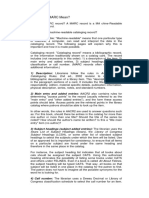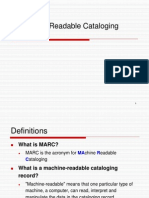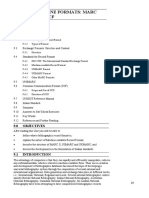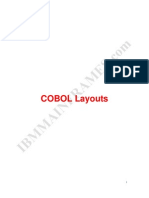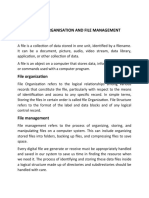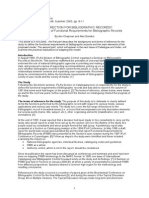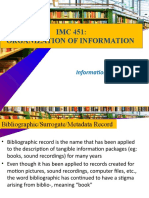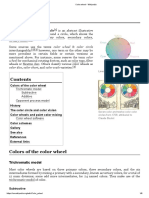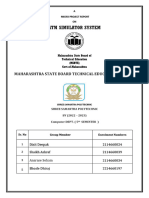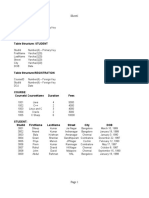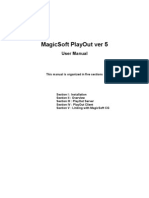0 ratings0% found this document useful (0 votes)
15 viewsUnderstanding MARC21
Uploaded by
HHHHCopyright
© © All Rights Reserved
We take content rights seriously. If you suspect this is your content, claim it here.
Available Formats
Download as PDF, TXT or read online on Scribd
0 ratings0% found this document useful (0 votes)
15 viewsUnderstanding MARC21
Uploaded by
HHHHCopyright
© © All Rights Reserved
We take content rights seriously. If you suspect this is your content, claim it here.
Available Formats
Download as PDF, TXT or read online on Scribd
You are on page 1/ 30
Understanding MARC21
Prof. Mohan Raj Pradhan
Objectives
After reading this chapter you will be able to
learn:
• Meaning of MARC
• Rules and structure of MARC
• Terminology used in MARC
INTRODUCTION
• MARC is an acronym, used in the field of library science
that stands for Machine-Readable Cataloging.
• The MARC consists of the standard record format for
computerized bibliographic information.
• It is a standard format for the transfer of bibliographic
records between automated systems.
• MARC records exist for bibliographic data, authority
data and for holdings data. Here, the discussion is
limited to MARC format for bibliographic data
MARC 21
Parts of a MARC record
Leader: identifies the beginning of a new record,
type of record
Directory: think of it as the index to the record.
Identifies the position and length of each field
Control Fields: coded information about the
resource described, standard/control numbers,
dates, language, etc. Some are called fixed fields
due to their fixed length
Variable fields: more detailed description of the
resource, fields have variable length
Structure of the MARC record
• The bibliographic database consists of many
records, one for each title in the collection,
and each record divides into fields that
describe each data element. The record
structure of MARC records is shown below:
Leader
• This is a fixed-length element, where each
position specifies various characters of the
record, including the length of the record and
base address of the record.
Leader..
• The base address is the number of characters
from the beginning of the physical record to
where the first data field begins. It has 24
characters.
Directory
• It consist a series of entries that contain a three-digit tag, field
length, and starting location of each variable field within a record.
• The first 24 positions are the leader. In this example the leader fills
approximately 1/3 of the first line and ends with "4500."
Immediately following the leader, the directory begins. Tags have
been underlined in this example. Each individual tag directory is 12
characters long. The first tag is 001. Following each tag, the next
four positions show the length of the field. The data in the 001 field
(control number) in this record is 20 characters long. The next 5
positions tell the starting point for this field within the data string
that follows the directory. The 001 field begins at the 00000
position (the first position is position 0). The next tag is 003, which
is 4 characters long and begins at the 20th position. [2]
Directory…
Directory..
A MARC record in the Exchange format
Data Fields-Control Fields
• All fields beyond the directory are named by a
three-digit tag. Control fields are fixed fields
for tags numbered from 001 to 008. The
purpose of the different control fields is given
below:
Data Fields-Variable Fields
Variable Fields..
• The 9XXs have been left for locally-defined
uses, such as local barcode numbers. Local
libraries, vendors, or systems can define and
use them for attaching other types of
information to records.
• (X9Xs in each of these groups -- 09X, 59X, etc.
-- are also reserved for local use, except 490.)
Variable Fields…
• The notation XX is used to refer to a group of
related tags. For example, 1XX refers to all the
tags in the 100s: 100, 110, 130, and so on
Variable Fields…
• 2XX refers to all the tags in the 200s. This
group of tags contains the title of the item
described in the bibliographic record and all of
the variant titles that also apply to the item.
Variable Fields…
Access points
• (a main entry, subject added entries, and
other added entries) are an important part of
the bibliographic record to retrieve an item. In
the traditional card catalog, separate cards
were created for the headings, known as
access points, which a patron or librarian
today would choose to search in an on-line
catalog.
• Most of the access points are in:
Access Points…
Variable Fields
• The bulk of data is in the variable fields section of the
MARC record. The variable field use indicators to qualify its
meaning and which can be divided into subfields. Each tag
is associated with a particular type of information.
• The record can contain whatever tagged fields are
necessary to describe the item adequately. When multiple
instances of the same type of information apply, the tag
can usually be repeated within the record.
• Each field contains a field terminator symbol that marks its
end as it is read by the computer. At the end of the last
field, a record terminator symbol marks the end of the
record.
Variable Field
Types of codes used to indicate content of a record (variable
field):
tags: 3-digit numbers (001-999) to encode fields
e.g. 100 = personal name main entry
indicators: 2 possible positions for each field, special
information about that field
e.g. 100 1_ = surname as the entry element
subfield codes: combination of a delimiter and a lower case
letter or number, to encode subfields
e.g. 100 1_ |a = name
Variable Fields…
Variable Fields…
• The three-digit tag “245” is defined by MARC as the proper field for
title information. The “10” represents the indicators digits. The
body of the field in the illustration is divided into three subfields.
• The subfield delimiter used here is the “$” symbol, and the letter 'a'
following the symbol is subfield code. Following this is the actual
data in the subfield. The last character – the ^ symbol – is the field
terminator. The subfield codes ($) and field terminator (^)
characters are nonprinting symbols but have been shown in above
example for clarity. In the example above,
• the three subfield codes a.b and c have specific meaning: “a” for
the main part of the title, “b” for other title information or for the
subtitle, and “c” for a statement of responsibility, listing the author,
editor, or translator.
Indicators
• Sometimes we want to tell the computer to
do more than just store the information.
• For example, in the 245 – Title and Statement
of Responsibility field, we want to indicate
whether or not the title should be an access
point in the catalog.
• We may also want to tell the computer to
ignore some character at the beginning of the
title when it files the title.
Example of Indicator
• In the example
• 245 1 4 $aThe country house :$bclassic style for an elegant
home /$cJenny
Gibbs ; edited by Alison Worleigton.
• 1 tells the computer to make an added entry for the title.
• 4 shows that four characters need to be ignored when the
title is filed in alphabetical order. So the item will be filed
under “c” for “country”, not “T”, “h”, “e” or the space.
• In the fields where indicators are not needed they are left
blank. The symbol # is sometimes used to represent a blank
(Given separately under the heading MARC codes)
Subfields and Subfield Codes
• The data elements within a field are called subfields
• Each subfield is introduced by a subfield code. These
codes enable the computer to identify all the pieces of
information that make up the record. Thus the system
can retrieve any information it needs.
• For example, in the publication, distribution field, the
place of publication is stored in subfield “a”, the
publisher in subfield “b” and the date of publication in
subfield “c”
• “a”, “b” and “c” are called data element identifiers.
Delimiters
• In AACR2 format, data elements are separated
by standard punctuation. In MARC format,
subfields are separated by symbols called
delimiters. In this lesson, we use the symbol $.
Depending on the computer system, the
delimiter may be a hash (#), a double dagger
(‡), a pipe (|) or another symbol.
MARC coding
• MARC coding is the process of assigning machine-
readable codes to bibliographic information.
• MARC based record prepares data for computer
recognition and manipulation, permitting the
exchange and sharing of records across various
automated system [3].
• There are various forms of MARC format e.g.
UNIMARC, MARC21 and UKMARC.
• In open source software Koha ILS, MARC21 is
used for bibliographic information
ADVANTAGES AND DISADVANTAGES
OF THE MARC RECORD
• The creation and maintenance of the library's
database involves significant expense and
effort and the library should take every
possible precaution to protect this
investment.
• MARC is most successful and durable
standards in the library environment.
Benefits
• System Migration
• Import of records from external sources
Disadvantages
• The complexities of the MARC record with all
its tags, indicators, fields and subfields can
make cataloging a difficult process. Many
libraries especially ones without the benefit of
professional catalogers may prefer a more
user-friendly approach
You might also like
- IST111: Introduction Organisation MARC Coding / Copy Cataloguing (Wk13)No ratings yetIST111: Introduction Organisation MARC Coding / Copy Cataloguing (Wk13)14 pages
- Model Catalog For UB LIS 571: Including A Summary of The MARC 21 FormatNo ratings yetModel Catalog For UB LIS 571: Including A Summary of The MARC 21 Format67 pages
- The Importance of Marc in Information Retrieval and Storage100% (5)The Importance of Marc in Information Retrieval and Storage16 pages
- Understanding MARC Authority Records: Parts 1 To 7No ratings yetUnderstanding MARC Authority Records: Parts 1 To 716 pages
- MARC Coding For Library Technicians 2019No ratings yetMARC Coding For Library Technicians 2019151 pages
- Subject Analysis In Online Catalogs 2nd Edition 2nd Edition Hope A Olson instant downloadNo ratings yetSubject Analysis In Online Catalogs 2nd Edition 2nd Edition Hope A Olson instant download84 pages
- Fundamental File Structure Concepts & Managing Files of RecordsNo ratings yetFundamental File Structure Concepts & Managing Files of Records49 pages
- Enterprise COBOL Concepts: Dr. David Woolbright Woolbright - David@columbusstate - Edu 2013No ratings yetEnterprise COBOL Concepts: Dr. David Woolbright Woolbright - David@columbusstate - Edu 2013254 pages
- Att - BJ Ywgwyew2zjoerg Uorlygpqojczt2xtb0oseakfyNo ratings yetAtt - BJ Ywgwyew2zjoerg Uorlygpqojczt2xtb0oseakfy12 pages
- A New Direction For Bibliographic Records? The Development of Functional Requirements For Bibliographic RecordsNo ratings yetA New Direction For Bibliographic Records? The Development of Functional Requirements For Bibliographic Records5 pages
- Marc Reference: Tag Indicators Subfields Punctuation Best PracticesNo ratings yetMarc Reference: Tag Indicators Subfields Punctuation Best Practices8 pages
- Systems Analysis & Design: Analyzing Systems Using Data DictionariesNo ratings yetSystems Analysis & Design: Analyzing Systems Using Data Dictionaries57 pages
- IMD213 Week 12 - Standards Used in Organizing InformationNo ratings yetIMD213 Week 12 - Standards Used in Organizing Information39 pages
- WK6-TMF1913-1014-SEM1-2022-23-LU7 DtDictionary PDFNo ratings yetWK6-TMF1913-1014-SEM1-2022-23-LU7 DtDictionary PDF46 pages
- Unimarc Manual Bibliographic Format 3rd Ed Alan Hopkinson Editor pdf downloadNo ratings yetUnimarc Manual Bibliographic Format 3rd Ed Alan Hopkinson Editor pdf download76 pages
- Analyzing Systems Using Data DictionariesNo ratings yetAnalyzing Systems Using Data Dictionaries60 pages
- 05.CA (CL) - IT - (Module-2) - (5) Information Technology-Data Resource ManagementNo ratings yet05.CA (CL) - IT - (Module-2) - (5) Information Technology-Data Resource Management20 pages
- Modeling Data in The Organization: Modern Database Management 6 EditionNo ratings yetModeling Data in The Organization: Modern Database Management 6 Edition53 pages
- User's Manual: Last Updated: October 25, 2013No ratings yetUser's Manual: Last Updated: October 25, 2013186 pages
- Teaching Finite Element Analysis For Design Engineers: August 2011No ratings yetTeaching Finite Element Analysis For Design Engineers: August 20117 pages
- How To Run A Simple HTML - CSS - Javascript Application On Heroku PDFNo ratings yetHow To Run A Simple HTML - CSS - Javascript Application On Heroku PDF3 pages
- DBMS - Assignment/Question/course - Stu - Regis - AssignNo ratings yetDBMS - Assignment/Question/course - Stu - Regis - Assign6 pages
- Adobe Photoshop CS6 - Win - Adobe - Free Download, Borrow, and Streaming - Internet ArchiveNo ratings yetAdobe Photoshop CS6 - Win - Adobe - Free Download, Borrow, and Streaming - Internet Archive1 page
- Ieee Guide For Collecting and Managing Transmission Line InspectNo ratings yetIeee Guide For Collecting and Managing Transmission Line Inspect50 pages
- Imanager U200 V200R014C60 Routine Maintenance 04No ratings yetImanager U200 V200R014C60 Routine Maintenance 0494 pages
- ASDM 6.4 Site To Site VPN Tunnel With IKEv2No ratings yetASDM 6.4 Site To Site VPN Tunnel With IKEv28 pages











